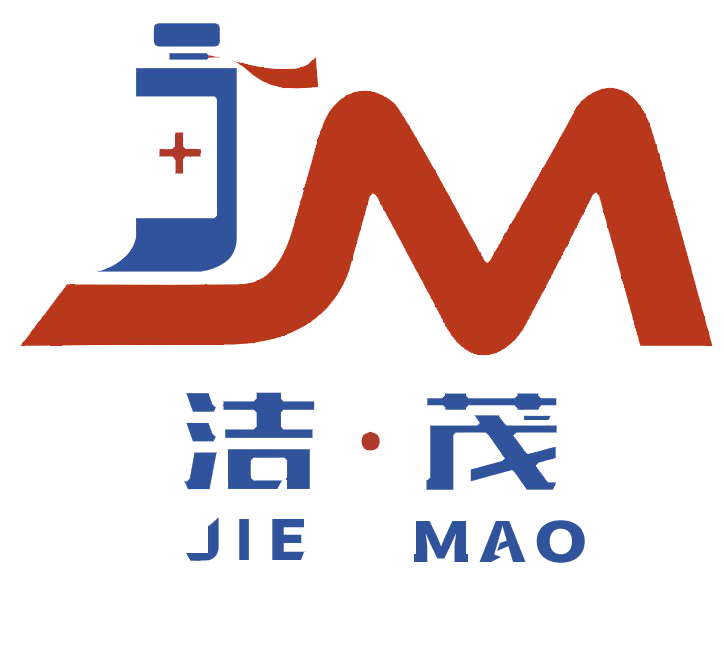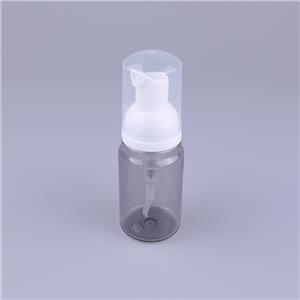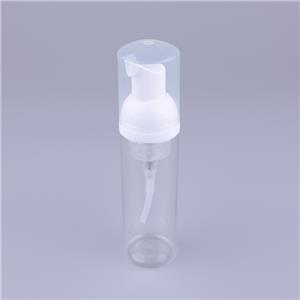- Home
- >
- News
- >
- Public Information
- >
- The production process of plastic syrup bottles
The production process of plastic syrup bottles
The production process of plastic syrup bottles
Plastic syrup bottles are usually made of food grade or medical grade plastics such as PET (polyethylene terephthalate), HDPE (high-density polyethylene), or PP (polypropylene). The production process mainly includes injection molding (preform) → blow molding (bottle body) → subsequent processing and other steps.
1. Raw material preparation
Plastic pellets: Use plastic raw materials that meet FDA (food grade) or GMP (pharmaceutical grade) standards (such as PET, HDPE, PP).
• Additives: May include anti UV agents (UV protection), antioxidants (extended shelf life), color masterbatch (dyeing), etc.
Drying treatment: Plastic particles need to be dried first (such as PET drying at 120-160 ℃ for 4-6 hours) to prevent moisture from affecting the molding quality.
2. Injection molding (manufacturing preforms)
Injection molding machine heating: Plastic particles melt into liquid form at 260-300 ℃.
Injection mold: Molten plastic is injected into the preform mold under high pressure (500-1500 bar), and after cooling, it forms a preform.
O Bottle preform structure: including bottle mouth (threaded part) and bottle body prototype.
Quality control: Check the wall thickness, size, and absence of bubbles of the preform.
3. Blow molding (stretch blow molding to form the bottle body)
Heating the preform: The preform is heated by infrared radiation to 90-110 ℃ (PET) to soften it.
• Stretch blow molding:
1. Longitudinal stretching: The mechanical rod stretches the preform downwards.
2. High pressure blow molding: Compressed air (20-40 bar) is blown in to expand the preform and conform to the shape of the mold.
• Cooling shaping: Rapid cooling (water or air cooling) to shape the bottle body.
Key points:
Mold design: Determine the shape and thickness of the bottle (such as reinforcing rib design to prevent deformation).
Aseptic requirements: Medicinal bottles must be produced in a clean workshop to avoid contamination.
4. Follow up processing
(1) Bottle mouth treatment
Thread reinforcement: Ensure the sealing of the bottle cap.
Aluminum foil sealing (for some pharmaceutical bottles): to prevent leakage or contamination.
(2) Printing and Labeling
Screen printing/heat transfer printing: printing scales, brand logos, instructions for use, etc.
Labeling machine: Automatically paste labels (such as ingredients, shelf life, etc.).
(3) Quality inspection
Sealing test: Apply pressure to check for air leakage.
• Compression test: Simulate the stacking pressure during transportation.
Microbial testing (pharmaceutical bottles): Ensure sterility.
5. Packaging and factory delivery
Automatic counting and packing: assembly line packaging, with a fixed quantity per box.
Sterilization treatment (some medical bottles): such as EO (ethylene oxide) sterilization or gamma ray irradiation sterilization.
Analysis of the prospect of using syrup bottles
As an important packaging container in the fields of medicine, food, laboratory, etc., syrup bottles are influenced by various factors such as industry development trends, material innovation, environmental policies, etc., affecting their market demand and application prospects. The following are the main development directions and opportunities for syrup bottles in the future:
1. Demand growth in the pharmaceutical industry
Driving factors:
• Increased demand for chronic disease drugs (such as cough syrup and diabetes oral liquid).
Expansion of the pediatric medication market (requiring safe bottle cap design, such as preventing children from opening).
Upgrading pharmaceutical packaging in emerging markets such as Africa and Southeast Asia.
Development trend:
Intelligent packaging: such as syrup bottles with RFID tags (tracking the authenticity and expiration date of drugs).
• Precise dosage design: Built in measuring cup, dropper or metering pump to reduce medication errors.
2. Innovative applications in the food and beverage industry
Main applications:
High end syrup (such as maple syrup, honey, coffee seasoning).
• Healthy drinks (such as vitamin syrup, probiotic oral solution).
Development trend:
Lightweight design: reduce plastic usage and lower costs.
Sustainable packaging: biodegradable plastic (PLA) or recycled PET (rPET).
• Convenience improvement: such as squeeze bottles, flip bottles, spray bottles, etc.
3. Laboratory and industrial use
Main requirements:
Chemical reagent storage (HDPE bottles with stronger corrosion resistance).
• Biological sample preservation (sterile, UV resistant brown bottles).
Development trend:
High barrier material: prevents oxygen and moisture from penetrating, extending the shelf life of reagents.
• Automated filling compatibility: Suitable for laboratory robot operation.
4. Environmental Protection and Sustainable Development Trends
(1) Application of Recyclable Materials
RPET (Recycled Plastic): Brands such as Coca Cola have promoted 100% recycled plastic bottles.
• Biobased plastics: such as PLA (polylactic acid), which can be compostable and degraded.
(2) Policy impact
EU SUP ban: Promote reusable packaging.
China's "plastic restriction order": encourages biodegradable materials to replace traditional plastics.
(3) Consumer preferences
Green packaging: Environmentally friendly brands are more favored by young consumers.
Deposit recycling system: For example, Germany provides deposit refund for PET bottle recycling.
5. Opportunities brought by technological innovation
Antibacterial bottle cap: reduces the risk of syrup contamination (such as silver ion coating).
Intelligent sensing bottle: Remind users of the remaining amount or expiration time of syrup.
Customized bottles: Small batch personalized production (such as high-end health products).
6. Challenges and Risks
Fluctuations in raw material prices: Petroleum based plastics are affected by crude oil prices.
Strict regulations: Drug packaging must comply with FDA, GMP and other certifications, which increases costs.
Alternative competition: Aluminum bags and glass bottles are replacing plastic syrup bottles in some fields.
Analysis of Global Syrup Bottle Usage and Market Data
The usage of syrup bottles is influenced by the demand of industries such as medicine, food and beverage, and laboratory. The annual consumption of bottles made of different materials (plastic, glass) and specifications (50ml~1000ml) varies greatly. The following are key data and trend analysis:
1. Estimated annual usage of syrup bottles worldwide
Annual usage in the field (estimated) Main material growth trend
The pharmaceutical industry has approximately 12-15 billion units of HDPE/PET/glass, with an annual growth rate of 4-6% (due to the increasing demand for chronic and pediatric drugs)
Approximately 8 to 10 billion PET/glass products for food and beverage, with an annual consumption of 3% to 5% (high-end syrup and healthy beverages)
Approximately 10-15 billion pieces of HDPE/glass+2% to 3% per year in laboratories/industries (biopharmaceuticals, chemical reagents)
A total of 21-26.5 billion units per year --
Note: The data is comprehensive from Statista, Grand View Research, and industry reports, including reusable bottles.
2. Divide usage by material
(1) Plastic syrup bottle (dominant market)
• Proportion: about 70%~75% (due to its lightweight and low cost).
• Common plastics:
HDPE (high-density polyethylene): accounting for over 50% (mainstream pharmaceutical bottles).
PET (transparent bottle): accounts for 30% (commonly used in food and beverage).
PP (high temperature resistance): accounts for 15%~20% (laboratory, hot filled syrup).
(2) Glass syrup bottle (high-end/special requirements)
• Proportion: Approximately 25% to 30%.
• Application scenarios:
High end honey and maple syrup (beautiful and fresh).
O Photosensitive drugs (brown opaque glass).
Laboratory chemical reagents (corrosion-resistant).
3. Regional market distribution
Driving factors for the growth of the proportion of annual demand in the main usage areas of the region
North American medicine, high-end food 30%~35% chronic disease drugs, healthy drinks
Strict regulations in Europe promote the use of recyclable materials in pharmaceuticals and environmentally friendly packaging, with a range of 25% to 30%
The rapidly growing pharmaceutical and food markets in the Asia Pacific region, with 25% to 30% of the population aging and consumption upgrading
Other laboratory/industrial use 10%~15% biopharmaceutical development
4. Key factors affecting usage
(1) Growth drivers
• Medical demand: The global aging population is intensifying, and the demand for cough syrup and vitamin liquid drugs is increasing.
Food innovation: Functional syrups such as collagen and probiotics drive the growth of small packaging bottles.
• Emerging markets: India, Southeast Asian countries upgrade drug packaging (replacing traditional bulk).
(2) Restrictive factors
Environmental policy: EU SUP ban restricts disposable plastic bottles, some companies turn to glass or biodegradable materials.
Alternative packaging: Aluminum plastic bags and upright bags replace some plastic bottles in the food industry.
5. Future usage forecast (2025-2030)
• Medical bottles: the annual growth rate is expected to be 4%~6% (driven by drugs for diabetes and respiratory diseases).
Food bottles: Annual growth rate of 3% to 5% (high-end and convenience demand).




